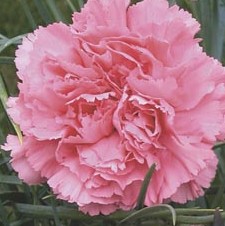
Carnations are short-lived herbaceous perennials native to the Mediterranean where they grow in pockets of soil in limestone formations. The grey-green foliage is linear and evergreen. The flowers are produced singly or in clusters of five in summer and usually have a strong sweet clove fragrance. The species was originally bright pinkish purple but white, yellow, red, purple, and green cultivars have been developed. Plants prefer cool climates and are short lived so must be divided every other year to maintain vigor. The flowers have a vase life of one to two weeks and are excellent for corsages. Plants are short lived and must be divided every other year to maintain vigor. The flowers have a vase life of one to two weeks and are excellent for corsages. The genus name, Dianthus, comes from the Greek words Δῖος (dios), meaning divine, and ἄνθος (anthos) meaning flower. The specific epithet, caryophyllus, comes from the Greek word καρυόφυλλον (karyophyllon), which was used to describe the clove tree (Syzygium aromaticum) and was later applied to carnations because of their clove scent.
Type: Herbaceous perennial
Bloom: Pink, red, white, yellow, purple, green flowers usually with strong sweet clove fragrance in summer
Size: 2’ H x 4’ W (if not tied up)
Light: Full sun
Soil: Fertile, moist, well-drained, limy (drainage is critical).
Hardiness: Zones 6-8
Care: High maintenance; grow in greenhouse; steak plants, divide every other year.
Pests and Diseases: Many viral, bacterial, fungal diseases and insect pests.
Propagation: Slip cuttings in spring and summer
Photo Credit: Wikipedia